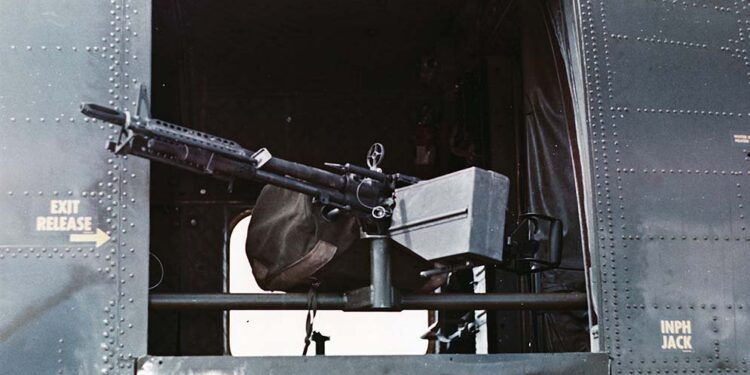By Joseph Trevithick
The U.S. Army came out of the Korean War with a firm understanding of the value of the helicopter. Even in the twilight of the conflict in East Asia, the Army had begun to rapidly expand its helicopter fleet. By 1956, the U.S. Army had developed plans for a “Sky Cavalry” to make use of what was still a relatively new type of aircraft. In addition to traditional cavalry roles, advocates of the helicopter in the Army were keen to exploit its troop carrying capabilities and also began to explore what was first termed “the Armair Brigade,” a proposal for a complete combined arms entity capable of sustained operations making use of helicopters. Parallel to these doctrinal developments, in June 1956, Colonel Jay D. Vanderpool, then the Chief of the Aviation School’s Combat Development Office (CDO), was tasked with investigating the idea of the armed helicopter. Armed helicopters were seen as integral to the proposed Sky Cavalry and Armair Brigade.
Transporting troops by helicopter and the defense of those helicopters during offensive operations may have seemed like obvious considerations, but many hurdles existed. The Army for one was reticent of the concept as a whole and few senior officers wanted to stake their reputation on the unproven concept. Exercise Sage Brush, which was held between December 1955 and January 1956, had soured many opinions in the Army of just how useful helicopters could be in direct combat after the performance of a provisional Sky Cavalry unit failed to meet expectations. During the exercise, the unit had been tasked with missions it had not been intended to perform, using decidedly unrefined tactics. Even the Commandant of the Army’s Aviation School at Fort Rucker, Brigadier General Carl I. Hutton, forced Colonel Vanderpool to work on helicopter armament in virtual secrecy, despite his personal convictions about the effort and having ordered him to conduct the armed helicopter development project in the first place.
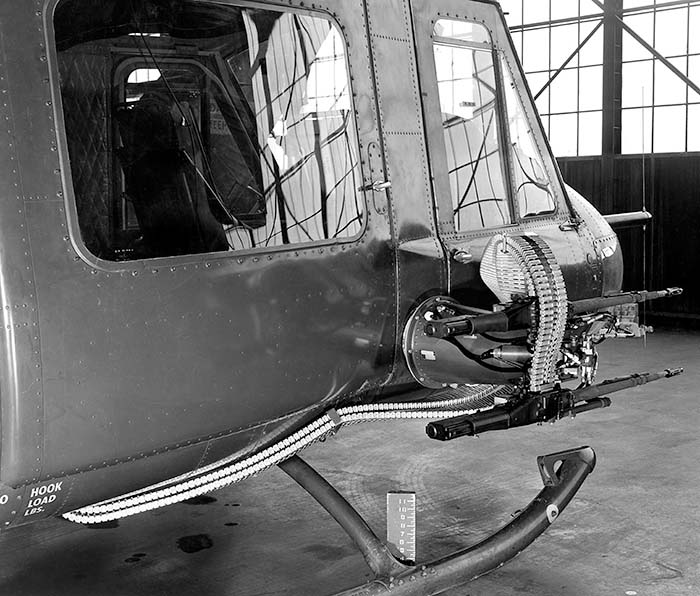
Perhaps more threatening to the overall program, however, was the fledgling U.S. Air Force. After its separation from the Army in 1947, the Air Force had done everything in its power to demonstrate its independence from its parent. The Army had signed a Memorandum of Understanding with the Air Force in 1951 that limited Army aviation to logistics and support functions and effectively precluded them from offensive operations. This had been taken by the Air Force to mean that the Army would not pursue armed aircraft of any kind and they consistently charged the Army with encroaching on its roles and missions.
While the Army continued to experiment and explore its options, active units remained rooted in existing doctrine and understanding. It was not immediately clear how vulnerable helicopters would necessarily be to an enemy, whether caught by surprise or having prepared a defense. Even as late as 1961, official Army airmobile doctrine emphasized speed and surprise to catch the enemy of guard and quickly seize an objective or to designate an uncontested landing zone some distance away from the objective to land forces at first. The doctrine emphasized the use of Army artillery fires and Air Force close air support, and later the use of helicopter gunships, to limit the enemy’s ability to threaten the airmobile forces.
Still, the work done on armed helicopters by Vanderpool’s experimental unit, quickly nicknamed “Vanderpool’s Fools,” did look at self-defense of troop transporting helicopters. Vanderpool’s men had access to the H-21 and H-34 types of helicopters (later redesignated as the CH-21 and CH-34 in 1962), which were in service with the Army at the time for moving men and materiel and armament subsystems were developed for both types. Older H-19s, which had been used in this function in Korea, were utilized more to test the concept of the gunship. Vanderpool’s experimental unit was designed with an organic lift component intended to carry organic infantry, a model that would carry over to the first formal air cavalry units.
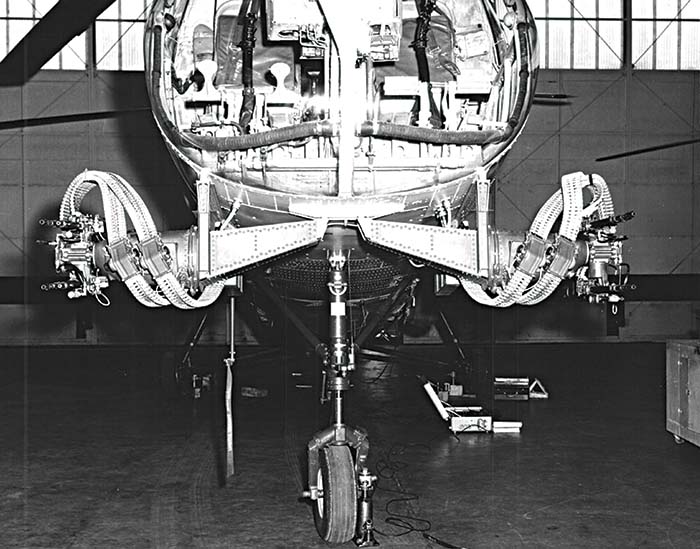
By the end of 1958, CDO had published a report for other interested units with step-by-step instructions on how to fabricate the numerous armament kits it had developed. This report included information about the specialized mounting hardware and covered systems for all types of helicopters including transports. No official nomenclature was assigned to these kits, but in September 1968, University of Southern California’s Division for Aerospace Safety and Management published a research report entitled the Evolution of the Armed Helicopter and Future Design Requirements as part of a course requirement for their Fort Rucker Branch. The author, Major C.O. Griminger, provided a simple and useful listing of the CDO’s systems using arbitrary letters, A through V, which will be used in this article to describe the kits in question. Kits M, N, O, P, U, and V involved systems featuring guns, as well as other weapons in some cases, for the H-21 and H-34 helicopters. The other kits involved various other types of weapons, such as just rockets or missiles, and other types of helicopters.
Kit M, mounted on an H-21C, had been developed by the Vertol Aircraft Corporation and consisted of three major components. The first was an armament package consisting of two .30 caliber AN/M2 machine guns and two .50 caliber AN/M2 machine guns, in addition to eight 8cm Oerlikon rockets, all on a fixed mount below the cockpit nestled around the front landing gear. The second was a cross bar and pintle assembly for a single M37 machine gun mounted at both of the aircraft’s cabin doorways. Lastly, firing ports in the aircraft’s cabin were provided to allow troops to fire at targets while in flight. The kit was specifically designed to provide transport helicopters with a means of softening up hard targets and otherwise defending themselves while landing and depositing their troops.
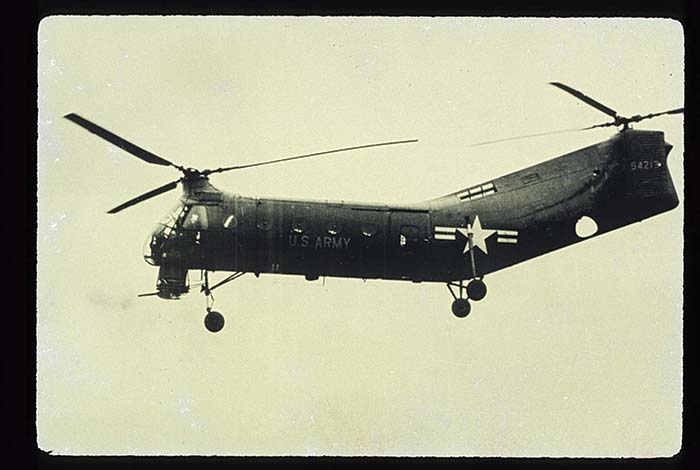
Kit N was a variation on Kit M’s first component, which replaced the Oerlikon rockets with two rocket pods capable of holding seven 2.75” Fold-Fin Aerial Rockets (FFARs). The pods had been fabricated by Packmeyer, Inc. for the U.S. Navy for training purposes and were subsequently acquired by Vanderpool’s unit. Kit P was another variation that featured either twelve or twenty-four launch tubes for 2.75” FFARs in place of either the Oerlikon rockets of the Packmeyer pods.
The last of the kits for the H-21 series, Kit O, was developed by the General Electric Company, and made use of a gun turret originally intended for the B-29 bomber. Kit O was installed into a suitable mount and fixed under the nose of an H-21C helicopter. The turret’s basic armament of two .50 caliber AN/M2 machine guns and ammunition storage and feed setup was unchanged. The system, designed to provide flexible fire for the helicopter as it approached the landing zone, overloaded the H-21C, but was felt to be practical in basic concept. A similar kit for the H-21C was subsequently developed by the Townsend Company called the Townsend Ground-Fire Suppression Kit. The kit featured a single .30 caliber M37 machine gun on a remotely flexible mount under the aircraft’s cockpit. The kit included an integral ammunition magazine built into the mount.
Kit U was a massive forward firing armament package for the H-34 helicopter. The kit consisted of two .30 caliber AN/M2 machine guns, two .50 caliber AN/M2 machine guns, two 20mm AN/M2 cannons, and two rocket pods for six T214 2” rockets each, with one of each weapon on each side of the aircraft. Kit V, also for the H-34, was more modest, featuring only four .50 caliber AN/M2 machine guns and two rocket pods for sixteen 2.75” FFARs each, again symmetrically distributed on each side of the aircraft. A similar kit to these for the H-34 was also developed under the direction of General Herbert B. Powell, the Commander of Fort Benning, beginning in 1956. That aircraft, later dubbed the “The World’s Most Heavily Armed Helicopter,” had two more forwarding .30 caliber AN/M2 machine guns in addition to Kit U’s gun armament, plus two more in the main cabin in the left side windows, along with another .50 caliber AN/M2 machine gun in the cargo door. In addition, the aircraft had two rocket pods for twenty 2.75” FFARs, as well as pylons for two 5” High Velocity Aerial Rockets. Tests of the single aircraft so configured ended in 1958 in part due to a lack of command support at Fort Benning, and the aircraft was sent to Fort Rucker to Vanderpool’s unit.
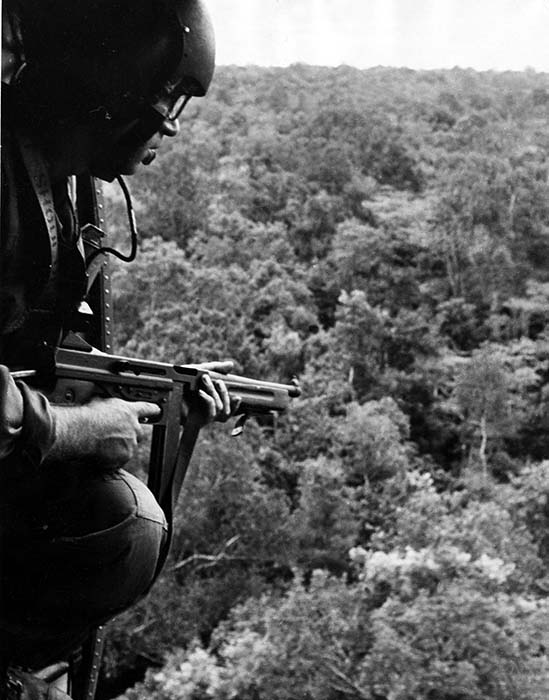
Despite these experiments, armament development for transport helicopters generally lagged compared to work being done for scout helicopters and the Army’s planned new breed of dedicated gunships. Still, important developments occurred. For one, the Army’s helicopter fleet was expanding. The U.S. Army began to take delivery of the new HU-1A Iroquois in 1959 (later redesigned as the UH-1A in 1962, but not before the popular nickname “Huey” had been coined) to replace the aging H-19 series of light helicopters. Work was also started on replacing the H-37 series of medium helicopters, which had not been part of any armament experiments. The result of that development was the HC-1B helicopter, which first flew in 1961 and was redesignated in 1962 as the CH-47A.
In addition, in November 1960, a tentative basis of issue plan for the newly developed XM153 armament subsystem was submitted to the Department of the Army. This basis of issue plan called for one subsystem to be issued per platoon in the transportation light helicopter company, transportation medium helicopter company, and utility tactical transportation company. The last unit type was a newly proposed entity developed as part of ongoing experiments in airmobility and was to be equipped with the new Huey helicopters.
The XM153 armament subsystem was developed by Emerson Electric beginning in 1958 as a common subsystem for the Army’s helicopter fleet. The XM153 designation eventually came to apply to the basic armament subsystem, while mounting kits for the H-21 series, H-34 series, and HU-1A aircraft were designated XM154, XM155, and XM156 respectively. The basic component of the kit was two sponsons, each with two 7.62mm M73 machine guns. Ammunition for the guns fed from magazines either inside the helicopter or mounted externally via flexible feed shoots to the guns. On the H-21, the sponsons were mounted on brackets under the cockpit, as had earlier kits tested by Vanderpool’s unit. On the H-34 and HU-1A the sponsons were mounted one on each side of the aircraft, in both cases positioned forward of the main cabin. This was as much for safety as anything else. The potential for guns firing into troops as they dismounted helicopters remained a major concern well after armament became more standardized. According to regulations, crews were not technically supposed to exit the aircraft until ground personnel had disconnected the weapon system’s power source and ammunition feeds and attached a grounding cable to the helicopter.
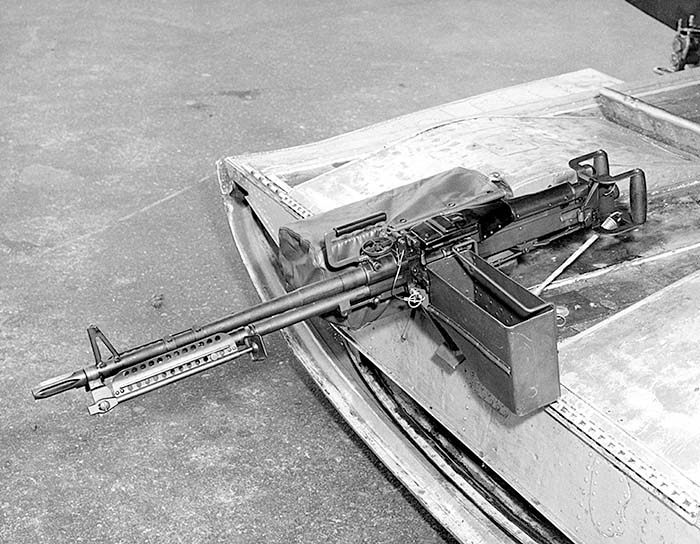
As the Army made progress in doctrine and materiel developments, the U.S. military was also expanding its involvement in Southeast Asia. The collapse of the French colonial presence there in 1954 had led American influence to fill the void in the newly independent nations of Cambodia, Laos, and South Vietnam. Although Laos was initially the main focus, South Vietnam had become the primary effort by 1962. U.S. advisors and support had begun flowing into Vietnam and this included transport helicopters to help the rapidly expanding Army of the Republic of Vietnam (ARVN) take the fight to the insurgents. The first U.S. Army aviation units, equipped with the H-21C helicopter, deployed to South Vietnam in December 1961. These deployments were followed by the deployment of the Utility Tactical Helicopter Company (Provisional) (UTTHCO) in 1962.
How armament kits were to be issued to aviation units was still being formalized as these units deployed and armament for the helicopters was limited. The CH-21Cs were generally fitted with the gun mounts at the cargo doors that had been developed by Vertol as part of the CDO’s Kit M. The UTTHC’s HU-1A helicopters, all designated as lift helicopters, had improvised armament fitted. The added weight of these kits was found to preclude the aircraft’s use as an armed transport as had been intended. The aircraft functioned primarily as gunships, escorting the CH-21Cs. Transport helicopters would eventually be nicknamed “slicks” for their general lack of protruding armament. The doctrine largely remained that escorting aircraft and artillery fires were responsible for protecting transports en route and during landing in airmobile operations. In most cases crew chiefs on all types of helicopters also carried whatever small arms could be scourged or otherwise had been made available to afford at least some semblance of self-protection, ranging from .45 caliber M1 submachine guns to .30 caliber M1 and M2 carbines to 7.62mm M14 rifles.
In December 1962, HU-1B aircraft, which were quickly redesignated as UH-1B, were delivered to the UTTHCO in Vietnam with XM6E3 armament subsystems. The M6 armament subsystem series was the outgrowth of the XM153 and was essentially the same, except that it replaced the M73 machine guns with 7.62mm M60C machine guns. These were versions of the Army’s standard infantry M60 machine gun intended to be fired remotely via solenoid trigger. The armament system was hydraulically flexible, which had also been a feature on the XM153. The guns were capable of an impressive sixty-three degrees of depression and eleven degrees of elevation. Though the guns could be “stowed” and fixed forward, they could also be rotated seventy degrees outboard and twelve degrees inboard from their stowed position. The guns were bore sighted to a flexible sight in the cockpit, which controlled the gun movement. A trigger was installed on the sight assembly, essentially allowing the gunner to place the reticule on the target and fire, so long as the target was within the guns field of fire. When firing off axis, the guns moving inboard were designed to automatically cut off, to prevent the gunner from inadvertently damaging the aircraft. When the guns were fixed forward they could be fired by the pilot using a fixed XM60 infinity sight. As with the XM153, the M6 series had been initially intended to be fitted across the Army’s helicopter fleet. The XM6 and XM6E1 were the designations of the kit for the CH-21C and CH-34 series of helicopters respectively. The XM6E2 and XM6E3 were intended for the UH-1 series. The only difference between the two was that the E2 variant mounted the weapons in front of the main cabin, while the E3 variant mounted the weapons behind the main cabin. In these instances the sponsons were attached to a Universal External Stores Pylon on each side of the aircraft, a rack and support assembly developed by Bell specifically for this purpose. The earlier XM153, and initially versions of the XM6E2, had been attached directly to the aircraft’s fuselage. The E2 had been intended for lift helicopters while the E3 was developed later for dedicated gunships. Though the E2 was tested on the UH-1B, as well as the long fuselage UH-1D which had first flown in 1962, it was found that the weight positioned so far forward had a serious effect on the aircraft’s center of gravity. In addition, armament had already dramatically affected the flight characteristics of the UH-1A and even the UH-1B, which featured a new engine, was noticeably sluggish when fitted with the XM6E3 subsystem. The XM6E3 was eventually standardized as the M6, the only version of the subsystem to be adopted for widespread use.
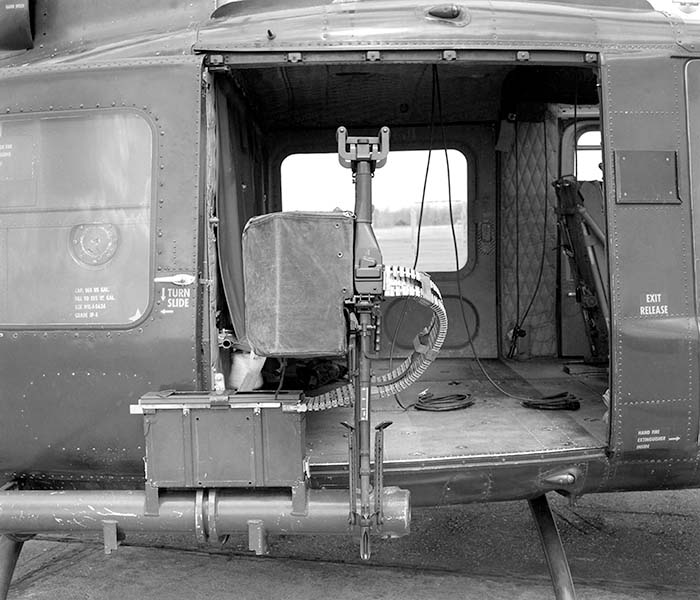
It had also been planned that the more powerful UH-1Bs would actually be able to both fill the role of lift helicopters and mount weapons. Experience with the UTTHCO in Vietnam showed that proposition to be impractical if not impossible with the new aircraft as it had been with the UH-1A. The combination of the light transport helicopter companies with their CH-21s and the UTTHCO with its UH-1s gave mixed results. Though the aircraft provided an important capability to the ARVN, an evaluation conducted by the Joint Operational Evaluation Group – Vietnam did not come to dramatically different conclusions from many observers of Exercise Sage Brush. Their findings, published in 1963, suggested that the armed helicopter as a concept might not be viable and that the Army should instead look to fixed wing aircraft, and as a result to the Air Force, to provide escort helicopters during airmobile operations. Their findings were influenced in part by what became a notable battle in the area around the hamlet of Ap Bac in January of that year. While a large number of factors had played a part in the debacle of an operation, the airmobile component of the force had seen two CH-21C aircraft grounded and also lost a UH-1B. Another CH-21C was severely damaged by ground fire. During the fighting, the ARVN never regained the initiative and the enemy force largely escaped.
Still, the Army remained largely undeterred and continued to develop its airmobile doctrine on the ground in Vietnam and back in the United States. To this end it activated the 11th Air Assault Division (Test) and 10th Air Transport Brigade in February 1963. These units were intended to refine and test Army airmobile doctrine using the Army’s expanding fleet of new UH-1B, UH-1D, and CH-47A helicopters, as well as fixed wing aircraft. Air Force objections eventually led to a further set of agreements about Army aviation, effectively limiting the Army’s fixed wing assets, but allowing their continued use of helicopters in offensive operations. In 1965, the 11th Air Assault Division was reflagged as the 1st Cavalry Division (Airmobile) and sent to Vietnam as part of the buildup of U.S. forces there.
In spite of its rocky start, the helicopter was there to stay as part of Army aviation. Helicopters quickly became an organic component of all Army division types and in separate brigades, and as the Army expanded its involvement in Vietnam they created separate combat aviation elements to provide additional helicopter support. The arrival of the UH-1D and CH-47A also meant that the Army finally had standardized self-defensive armament for its main transport helicopters.
The first of these was the M23 armament subsystem for the UH-1D, which consisted of relatively simple mounts on either side of the helicopter, each with a single M60D machine gun. The M60D featured spade grips and a flip up rear sight specifically intended for use as a flexible aircraft gun. The mount consisted of a drum attached to the aircraft’s rear hardpoints with a pedestal and a pintle mount allowing the weapon to be flexed in various directions. Ammunition fed via flexible feed chuting from a box with a thousand-round capacity fixed to the bracket holding the drum. A catch bag for expended links and cartridge casings could also be fitted. The mounting was not universally liked by troops in Vietnam as it was seen as both overly restrictive and not restrictive enough. The mount made it difficult to depress the weapon to fire at low targets and the feed chuting limited the traverse. However, the pintle also had no feature to prevent the weapons from over traversing and potentially firing into the aircraft. The feed chuting was also often done away with, with the ammunition feeding unrestricted into the weapon. To help overcome the subsequent problem of increased jamming, ration cans were affixed to the feed tray of the M60 to help guide the rounds. Bamboo poles and other protuberances were mounted to help prevent the weapon from being over traversed.
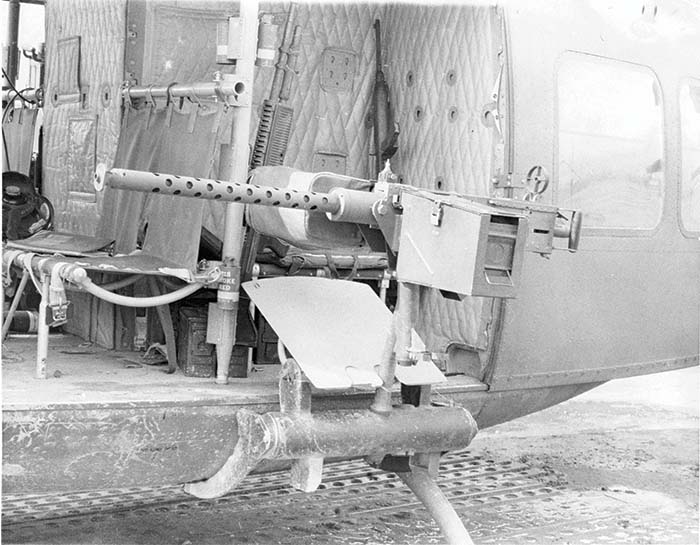
For the CH-47 series two armament kits were developed. The M24 armament subsystem provided cross bars and pintles for M60D machine guns at the front cabin door and forward emergency window. These were mounts were very similar to the mounts developed by Vertol for the CH-21C, but included a more traditional mount for a standard two-hundred round ammunition box. Later an armament subsystem for mounting on the aircraft’s rear cargo ramp was also developed. The M41 provided a mount and pintle for a single M60D machine gun. Both systems performed a service, but at the main cabin door the M24 especially restricted egress, both by disembarking troops and by crew in the event of a crash.
Also, while the short fuselage UH-1s, such as the UH-1B and UH-1C, remained used almost exclusively in the gunship role, some continued to operate as utility transports. A derivative of the M23, the XM29, was developed for these aircraft, which featured an extended drum, as the position of the aircraft’s hard points made it impossible to effectively mount the M23. It was not adopted for widespread use and instead these aircraft largely made use of door gun arrangements used on gunships. These include the so-called Sagami Mount, which had been first fabricated for the UTTHCO at the Sagami Army Depot in Okinawa, Japan. This involved a flexible mount for either side of the aircraft that attached either to the front of the cross bar of the Universal External Stores Pylon or via some other arrangement to the aircraft’s rear hard points and featured a pintle, intended to be fitted with a single infantry type M60 machine gun.
The Army had also tested a similar type of arrangement that affixed to the aircraft’s rear cabin bulkhead and mounts that attached to the cabin floor, as well as a wide array of potential weapons as door guns including heavy barrel M16s, the Stoner 63 in the medium machine gun configuration, and the 40mm M75 grenade launcher. None of these were put into service.
Though the Sagami mount saw significant use, it suffered from many of the same issues as the M23 and many door gunners on short fuselage aircraft took to carrying “free” infantry type M60s without any mounting hardware at all. There were concerns about the weapon falling out of the helicopter during evasive maneuvers or if the gunner should become injured. This led to the use of bungee cords attached to the weapon’s carry handle to secure it to the cabin roof. Forward grips were also fabricated using spare M60 pistol grips, stock aluminum, or other materials, to improve handling.
Though armament for transport helicopters remained essentially unchanged during the conflict in Vietnam, some additional developments were made. Units in the field had already looked into sourcing heavier armament for their helicopters and the Army eventually developed a reinforced version of the M23, the XM59. The new armament subsystem was intended to accept either the M60 machine gun as before, the M213 machine gun, or the 40mm XM175 grenade launcher. The M213 machine gun was essentially a refurbished .50 caliber AN/M2 aircraft machine gun, which featured both a lighter overall weight and a higher rate of fire compared to the infantry gun. The XM175 was one of a number of 40mm grenade launchers developed to try and provide such a system for wider spread ground and aircraft use. Floor mounts with pintles equipped with the M134 machine gun, a high rate of fire weapon nicknamed the “Minigun,” or the 40mm M129 grenade launcher were also developed. These weapons were already being used in many helicopter armament subsystems, and the armament subsystems were designated XM93 and XM94 respectively. The Army would decide against the XM93 and XM94, but the XM93 saw significant use with the U.S. Air Force and U.S. Marine Corps.
Also, while .50 caliber machine guns, including a further development of the XM213 designated as the XM218, did see some amount of use as door guns, 40mm grenade launchers did not. In testing it was found that the relatively low velocity of even the “high velocity” 40mm rounds meant that it was hard to accurately place rounds on targets parallel to a fast moving aircraft. The rounds would impact well after the aircraft had passed the intended target, making it hard to determine hits and misses. In addition, a safety issue existed. The 40mm rounds were armed by the spinning of the round as it left the barrel. Fired into the aircraft’s rotorwash and slipstream their movement could be easily disturbed, which in turn meant that rounds could easily fail to arm.
The Army had also never completely given up on the idea of a suppressive fire system for landing helicopters. Potential helicopter landing zones remained relatively obvious to the enemy, who was inclined to mine and booby-trap such sites or deploy large numbers of anti-aircraft weapons adjacent to them. To combat this, UH-1D and later UH-1H helicopters were fitted with smoke screen generators to hide their approach. Lift helicopter units also developed improvised dispensers for dropping CS “tear gas” grenades and were eventually authorized purpose built cluster bombs, which could be manually dropped out of the main cabin onto enemy positions. The Army also investigated the potential for mounting a variant of the XM55 Counter Ambush Barrage Weapon System on UH-1 helicopters, which had been developed for truck convoy protection. The helicopter variant featured a mount for four XM215 “multiple barrel guns” positioned under the aircraft’s nose. The XM215 was a cluster of three hundred and six .22 caliber barrels, each preloaded with a single M24 ball cartridge.
In spite of these tests and others, defensive armament for the Army’s transport helicopter fleet remained essentially unchanged for most of the period Vietnam. The first major change came with the Utility Tactical Transport Aircraft System (UTTAS) program that was started in the 1970s to replace the UH-1 series. The resulting aircraft, the UH-60A, featured dedicated gunner positions, but the armament subsystem, the M144, still just featured two M60D machine guns, one on each side the aircraft. The scissor-armed mount did allow the weapon to be stowed inside the aircraft and the gunner’s window to be closed against the elements. This had been a concern with the UH-1 operating in cold weather environments, as the main cabin had to be open to allow the use of the M23 subsystem. This problem had never been resolved despite a program to develop a kit to protect the gunner and passengers from the elements by the Army’s Land Warfare Laboratory in the 1970s. The M24 and M41 armament subsystems continued to be used by improved members of the CH-47 family without any significant changes.
The adoption in 1996 of the 7.62mm M240B machine gun by the Army as a replacement for the M60 in the infantry role provided the only real change in transport helicopter armament in decades. A flexible variant for use on aircraft was procured as before, the M240D, which became the standard armament. No significant modifications to the overall design of the M24, M41, or M144 armament subsystems were required to accommodate the new weapon. A combination ammunition feed and catch bag for cartridge casings and links was introduced for the M41 and M144 armament subsystems along with the further improved M240H, which was in the mid-2000s. This could not be fitted with the M24. The M240H itself featured additional accessory rails and a new flash hider in addition to other product improvements.
Only in February 2006 did the U.S. Army release a technical bulletin for the M24 to note that older M24 gun mounts might have defective limit stops, which would prevent the weapon firing arc from intercepting the aircraft’s fuel tank. The bulletin indicated that new subsystems would have properly functioning firing stops and that these were required to be fitted to existing subsystems as well. In 2008, the first major modification to one of the standard armament subsystems occurred when a new variation of the M24 was developed. The new M24E1 featured a swing arm mount instead of the fixed cross bar. The mount was also specifically intended for the new M240H and provided a M24E1-specific combination ammunition feed and catch bag arrangement. The Army had delivered one hundred and twenty M24E1 mounts for operational evaluation by 2011. A follow-on variant, the M24E2 (initially referred to as M24E1 Mod 1) allowed for the swing arm to move outboard, as well as inboard, to assist in evacuation of the aircraft in the event of a crash. This had continued to be an issue starting with the Vertol developed system on the CH-21C in the 1950s and then with the original M24 subsystem for the CH-47A in the 1960s.
The Army continues to look into improving the defensive fire power of its lift helicopters and is also looking to develop a follow-on set of aircraft to replace the current fleet as part of the Future Vertical Lift (FVL) program. The desired final product of the FVL program could be a traditional helicopter, compound helicopter, tiltrotor, or another type of design, and would likely require the development of an aircraft specific defensive armament suite. It is likely that new weapons might play a part in this or be added to existing subsystems, such as potential new lightweight machine gun developments. Existing armament subsystems, however, will likely continue to remain largely unchanged.
| This article first appeared in Small Arms Review V18N1 (February 2014) |



